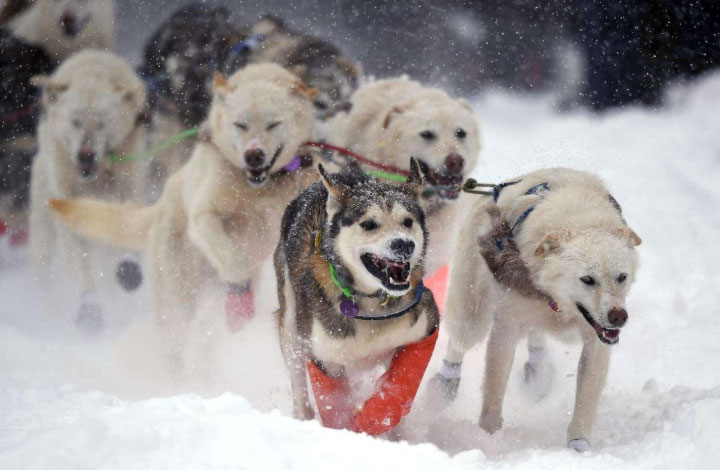Ancient sled dogs helped humans survive in the Ice Age
New research shows that ancient dogs adapted to the cold helped early humans survive in the Arctic more than 10,000 years ago.
This study compared the genetics of modern sled dog breeds, including Alaska and Siberian husky dogs as well as Alaskan Malamute dogs and Greenland dogs with DNA from a dog that lived 9,500 years ago on Zhokhov Island, in on the Arctic Circle in Eastern Siberia, the earliest archaeological evidence of sled dogs.
The researchers determined that the sled dog breeds and the old dog breeds share many of the same genes, forming a separate line that shows the origin of the sled dog and showing their importance to the life of the dog. people when humans arrived at the North Pole near the end of the last Ice Age.
Shyam Gopalakrishnan, a population geneticist at the University of Copenhagen and lead author of the study, said that he can move large amounts of furniture, move and assist people in finding food. over large spaces in such difficult terrain would be a huge advantage. It is a tool to help people settle in the North Pole.

Modern sled dogs can thrive on a high-fat and low-carb diet.
Gopalakrishnan continues to compare the DNA of ancient Siberian dogs with DNA sampled from 134 modern dogs, including 10 Greenland dogs, which are thought to closely resemble ancient sled dogs. They also compared the DNA from the 33,000-year-old jaw of a wolf found in northeastern Siberia, similar to the original wolf genome that modern dogs have.
The research results show that among dogs, Greenland dogs have the genes closest to the wolves , while other sled dogs are closer to Greenland dogs than other dogs.
The researchers identified modern sled dog breeds that shared a genetic line at least 9,500 years old and suggested that the sled dogs could be genetically different from other dogs about 15,000 years ago.
Ancient Siberian dogs also show that some adaptations will help it survive in very cold conditions , including longer fur and thick pads on the legs, which can help run further on snow and ice. Modern sled dogs retain these adaptations, Gopalakrishnan said.
There is also evidence that modern dog sleds can thrive on a high-fat and low-carb diet , which became normal for people in the Arctic for thousands of years before focusing. Hunt sea animals, such as seals, walruses and whales.
Most of the food comes from hunting, so these dogs can be fed uneaten food from residents living there. The study also supports the idea that domesticated dogs occurred about 35,000 years ago, much earlier than thought.
Scientists used to believe that humans domesticated dogs from wolves 10,000 to 15,000 years ago, but the evidence for genetic support is extensive. Dogs had different populations 10,000 years ago and one would imagine that domestication had been quite long before.
Robert Losey, an archaeologist at the University of Alberta in Edmonton, who has studied collars in Russia and North America, said these sled dogs have adapted to life with the people of the North Pole, in cold environments really very early.
In addition, animal geneticist Ben Sacks of the University of California said the study shed light on the origins of Neolithic dogs, including the Greenland and Inuit, and the wild dogs of Australia and New Guinea. Both native American dogs and wild dogs in Australia are in danger of extinction, so research provides an incentive for efforts to conserve these populations.
- The arthritic gene helped the ancient people survive the Ice Age
- The dog recognizes the smile
- Dog fangs threaten the polar bear
- Amazing metabolism in sled dogs
- Dog breeds like to use 2 front legs like boxers
- How to tame the ferocious nature of a hybrid dog
- 10 most exotic dogs on the planet
- Dogs or cats love humans more? There have been official conclusions from science!
- Home dogs originated from European wolves
- Dogs have a different way of understanding words than humans
- Domestic dogs are formed by the 'landfill'.
- Dogs can find errors in simple calculations
 Animal 'suffering' after hibernation
Animal 'suffering' after hibernation Why do goats climb well?
Why do goats climb well? Scientists were surprised to see chimpanzees eating turtles
Scientists were surprised to see chimpanzees eating turtles Giant catfish died deadly due to drought in Thailand
Giant catfish died deadly due to drought in Thailand